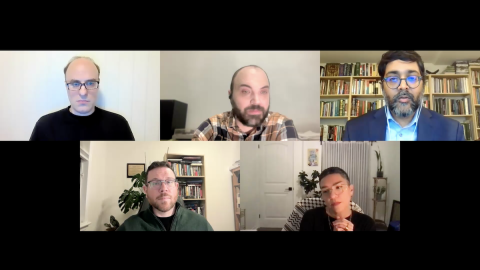The Kids Are Not All Right: Freedom of Expression and the Online Classroom
I don’t want to read one more piece that begins, “In these difficult (unprecedented, challenging, etc.) times,” and neither do you. However, since the world changed, I have serious and long-term concerns about teaching and free expression. Now that the greater part of the K-12 experience has moved online or to other internet based instruction, and at the same time society has become less tolerant of unpopular opinions, I fear that we may be developing a generation of students who do not know how to disagree without becoming disagreeable.
Most teachers are struggling to maintain their classroom programmes, especially not knowing what schools will be like in the new term. Will there be a regular, full classroom? Probably not – most classrooms are not large enough for the students they have now. If we need to ensure a two-meter space between desks, it will not be possible for the whole class to attend at one time. Will all instruction be via the internet? Again, probably not. Parents are desperate to get their kids back to school, and many are dissatisfied with the kind of education offered since schools were locked down. It seems that we are likely to see a hybrid model of teaching that will reduce teacher-student contact hours.
My fear is that most students will face abbreviated time for crucial discussion and interaction, the kind of interaction that exercises critical thinking.
Teachers had a great deal of curriculum that they were obliged to deliver – even before the pandemic was declared. This has not changed even though the number and quality of contact hours have diminished considerably. If it is easier and less troublesome to have students answer prepared questions and to discuss their views in written format, will the teachers accept the challenge of creating opportunities for deep interpersonal discussion? It is hard to imagine that many will.
In a study[i] that my colleague Dr. Yvette Daniel and I did at the University of Windsor, we found that the majority of teacher-candidates interviewed reported that their mentor teachers saw critical thinking as an “add-on” to lessons. And many said their mentor teachers felt that most of the elementary students were either “not ready” or at “too low a level” to engage in critical thinking. Sadly, most of the teacher-candidates shared these beliefs.
Teaching is a very difficult profession. It is also a vital one. If our young people do not learn the habits of democracy at an early age, they run the risk of never understanding that they matter and that they can make a difference. Who will stand up when someone is silenced for having an unpopular opinion, if they have never experienced a discussion where such views are aired? Who will fight for the rights of disadvantaged people if they have never disagreed with a fellow student in a situation where the disagreement can be turned into a civil debate?
Teachers who are considered exemplary online educators are creating assignments where they ask students to come up with two opposing opinions on a question. This is not bad, but students will not hear from classmates that there may be several other opinions that they never heard or knew to consider.
The quiet students who sat placidly in the back of the classroom before the pandemic, are still sitting quietly. They still don’t wish to expose their views. But if the teacher has a Zoom screen with twenty-five or thirty faces on it, she may not notice that some students never participate. (I heard a story about a few elementary students who discovered they could post a photo of themselves on the Zoom screen. If the teacher notices, they claim their computer froze. In the U.S. almost 20% of high school students never logged on at all. This would be hard to do in real life!)
Does everyone have equal access to computers? Of course not. There are places where internet coverage does not exist, where the family member who works from home is the one who needs the computer all day, where there are no computers in the family at all, where a family’s religious or cultural beliefs make computer use problematic, and many other obstacles to online learning.
All democracies require that children be provided with a free and equitable education. We are supposed to be teaching them in a way that promotes their active participation in civic life. What are we to do?
I do not know the answer to this serious problem. We cannot expose our teachers, adult staff, and students to a potentially deadly virus. Nor can we afford to lose a generation of lively minds. Education has never before demanded so much creativity and change. We were doing a mediocre job before the pandemic. We must do better. Teachers, we are calling on you to drop some of those work sheets and find new ways to engage your students in exciting and challenging opportunities to explore their rights and freedoms. We all stand to learn a great deal.
[i] Yvette Daniel and Danielle McLaughlin, “The ‘Shirtless Jogger’ and other Important Educators: ‘Thinking Otherwise’ to Promote Human Rights and Social Justice.” Pp. 267-288 in William T. Smale, Perspectives on Canadian Educational Law and Policy, Burlington, ON: Word & Deed Publishing Incorporated. 2018.

